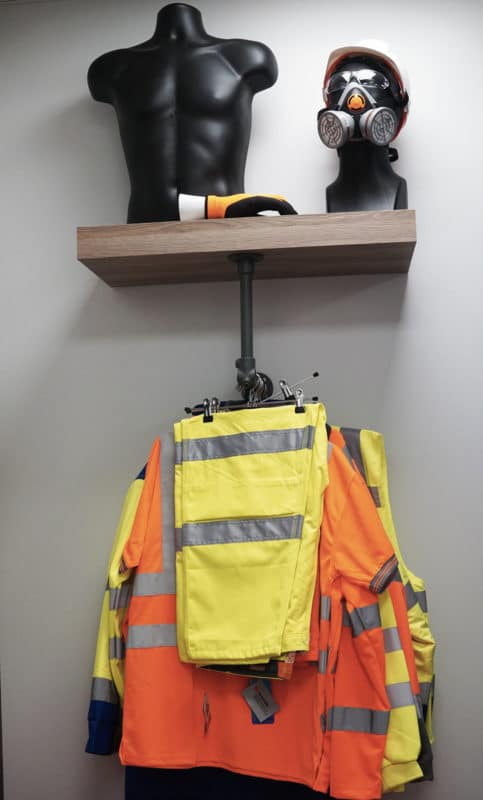What is PPE?
Personal Protective Equipment (PPE) refers to wearable items and clothing that protect individuals from possible health and safety risks at the workplace.
PPE is particularly important for those working in construction and in hazardous environments, for use when all other safety precautions have already been put into place but there may still be a risk to workers.
Employers have a responsibility to provide their workers with the correct PPE for their job, and ensure that it is maintained and used correctly.
SHOP BRANDED PPEPPE Legislation
PPE and associated products fall under the Personal Protective Equipment at Work Regulations 1992, a set of regulations created under the Health and Safety at Work etc. Act 1974.
These regulations came into place on 1 January 1993, and they clearly define an employer’s duty to ensure that the correct personal protective equipment is provided to employees that are working in hazardous conditions.
The regulations impose strict requirements in relation to:
1.
“…compatibility of items of personal protective equipment where it is necessary to wear or use more than one item simultaneously.”
Every employer needs to ensure that if there’s more than one risk to the health and safety of an employee, and the employee therefore needs to wear more than one item of protective equipment, that those pieces of equipment are fully effective against the risks posed in spite of each other.
2.
“…the making, review and changing of assessments in relation to the choice of personal protective equipment.”
Companies are required to have their own reviews and assessments in place to guarantee the effectiveness of their protective equipment.
3.
“…the maintenance (including replacement and cleaning as appropriate) of personal protective equipment.”
If items of protective equipment are broken, breaking, malfunctioning or anything in between – they need to be put to one side so they aren’t used, and then replaced if they cannot be maintained back to full effectiveness.
4.
“…the provision of accommodation for personal protective equipment.”
Every employer should ensure that appropriate accommodation is provided for personal protective equipment when it isn’t being worn, and employees should take all reasonable steps to ensure that the equipment is returned to the accommodation post-use.
5.
“…the provision of information, instruction and training.”
If employers provide protective equipment, they must ensure that it is supplied alongside adequate and appropriate training in how to utilise it effectively.
6.
“…ensuring personal protective equipment is used.”
Finally, every employer should take all reasonable steps to ensure that the protective equipment is being used effectively by employees, in line with the information and training that has been given.
Hierarchy of Hazard Controls
The best way to conduct thorough workplace assessments and apply suitable measures is to work through the hierarchy of controls.
A risk assessment should be carried out in order to decide whether or not a worker requires PPE. All equipment to be provided should be tailored to each individual depending on the job they are doing, and the hazards involved.
Information, instruction and training
To ensure correct application of PPE, information, instruction and training should be supplied.
The training should cover not only how to use the equipment effectively, but also:
1.
How to follow through on end-of-day storage procedures
2.
How to maintain the equipment in an efficient state
3.
How to spot faults in the equipment
4.
How to repair the equipment as required by regulation
Of course, the extent and depth of the information supplied is going to vary drastically depending on the role, and the types of equipment at use.
Maintenance systems are critical to guarantee the long term effectiveness of protective equipment. PPE manufacturers and suppliers will distribute maintenance schedules alongside any equipment and these should always be adhered to.
When storing PPE employers need to consider protection from the elements, tampering and theft. Equipment can become contaminated by rain and sunlight if it isn’t stored away safely.
Our PPE experts here at Essential Workwear can advise on how to safely store and maintain your equipment.

Branded PPE at Essential Workwear
Respiratory Protective Equipment (RPE)
Face masks are vital pieces of equipment to be used to protect the wearer from inhaling hazardous substances such as gases, dust, powders and vapours.
BROWSE RESPIRATORY PROTECTIONHearing Protection
Suitable hearing protection such as ear defenders, ear muffs and ear plugs are essential for those who are regularly exposed to noise at or above the Exposure Action level set by The Control of Noise at Work Regulations 2005 to ensure that workers’ hearing is protected to prevent hearing loss or other damage such as tinnitus.
BROWSE HEARING PROTECTIONHead Protection
The correct headwear such as safety helmets or bump caps are essential for ensuring protection against many different elements including falling materials, swinging objects and bumping into stationary objects.
BROWSE HEAD PROTECTIONEye Protection
Safety glasses, safety goggles and face shields are all important pieces of eye protection in preventing materials, dust, gases and fumes entering the eyes.
BROWSE EYE PROTECTIONFoot Protection
Adequate footwear is crucial for protecting the feet whilst working in construction, demolition or labouring where heavy objects risk falling on the feet. There are a variety of different types of safety footwear including steel toe capped safety boots or shoes and wellington boots, also taking into account the importance of slip resistant soles.
BROWSE FOOT PROTECTIONHand Protection
Safety gloves become an essential part of PPE when handling abrasive or sharp objects, operating vibrating equipment, dealing with hazardous substances and in general construction work.
BROWSE HAND PROTECTIONBody Protection
Some workers may require body protection PPE such as harnesses when working at height, or high visibility clothing when working in dimly lit conditions and in environments with vehicular traffic.
BROWSE BODY PROTECTION
